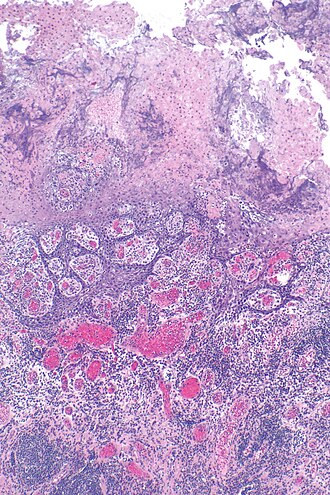Keratinising squamous metaplasia of the urinary bladder
Jump to navigation
Jump to search
| Keratinising squamous metaplasia of the urinary bladder | |
|---|---|
| Diagnosis in short | |
 Keratinizing squamous metaplasia of the bladder. H&E stain. (WC/Nephron) | |
|
| |
| LM | squamous epithelium with hyperkeratosis or parakeratosis, negative for atypia |
| LM DDx | squamous dysplasia of the metaplastic epithelium, squamous cell carcinoma of the urinary bladder, metastatic squamous cell carcinoma, urothelial carcinoma with squamous metaplasia or squamous differentiation |
| Site | urinary bladder |
|
| |
| Clinical history | usually males (males:females = 4:1) |
| Prevalence | rare |
| Prognosis | benign, increased risk of malignancy |
| Treatment | clinical follow-up |
Keratinising squamous metaplasia of the urinary bladder is a rare benign change of the urinary bladder associated with an increased risk of malignancy;[1] however, it is not considered a pre-malignant condition.[2][3]
Urinary bladder with squamous metaplasia and squamous metaplasia of the urinary bladder redirect to this article.
General
- Rare.[3] ‡
- Large age range (13-80 years).[1]
- Predominantly males - almost 4:1 (27 males:7 females in one series[1]).
Treatment:
Note:
- ‡ Non-keratinizing squamous metaplasia can be considered normal and is relatively common in the trigone region of the bladder in women.[citation needed]
Microscopic
Features:
- Squamous epithelium with hyperkeratosis or parakeratosis.
- Negative for significant nuclear atypia.
DDx:
- Squamous dysplasia of the metaplastic epithelium.
- Squamous cell carcinoma of the urinary bladder.
- Metastatic squamous cell carcinoma, e.g. squamous cell carcinoma of the uterine cervix.
- Urothelial carcinoma with squamous metaplasia or squamous differentiation.
Sign out
Urinary Bladder Lesion, Biopsy: - Extensive keratinizing squamous metaplasia with degenerative changes and acute and chronic inflammation. - NEGATIVE for dysplasia and NEGATIVE for malignancy. Comment: Regular follow-up is recommended.[1,2] 1. Urol Int 81 (3): 247-51. doi:10.1159/000151398. PMID 18931537. 2. Urologia 87 (2): 97–100. doi:10.1177/0391560318810197. PMID 30509153.
See also
References
- ↑ 1.0 1.1 1.2 Khan, MS.; Thornhill, JA.; Gaffney, E.; Loftus, B.; Butler, MR. (Nov 2002). "Keratinising squamous metaplasia of the bladder: natural history and rationalization of management based on review of 54 years experience.". Eur Urol 42 (5): 469-74. PMID 12429156.
- ↑ Kvist, E.; Sjølin, KE.; Laursen, H.; Orntoft, TF.; Sturmer, MA. (Jul 1992). "Squamous cell metaplasia of the bladder urothelium. A retrospective study of 36 patients.". APMIS 100 (7): 650-4. PMID 1379440.
- ↑ 3.0 3.1 3.2 Ahmad, I.; Barnetson, RJ.; Krishna, NS. (2008). "Keratinizing squamous metaplasia of the bladder: a review.". Urol Int 81 (3): 247-51. doi:10.1159/000151398. PMID 18931537.
- ↑ Benelli A, Varca V, Vaccaro C, Guzzo S, Nicola M, Onorati M, Gregori A, Di Nuovo F (May 2020). "Keratinizing squamous metaplasia of the bladder: Our experience and current approaches". Urologia 87 (2): 97–100. doi:10.1177/0391560318810197. PMID 30509153.